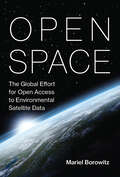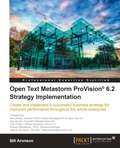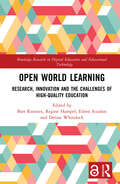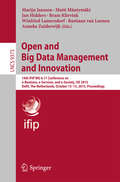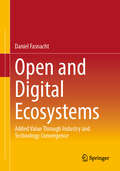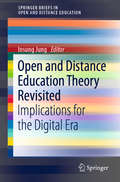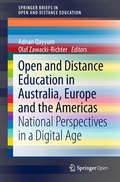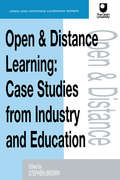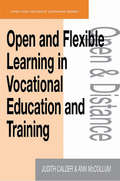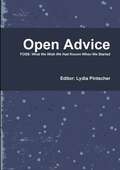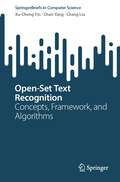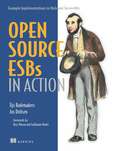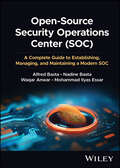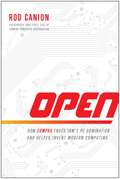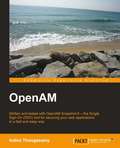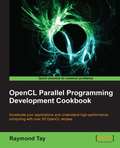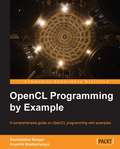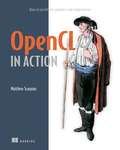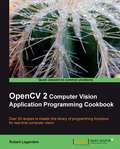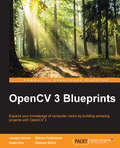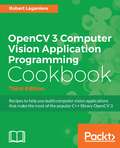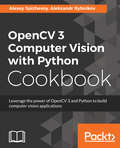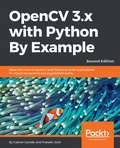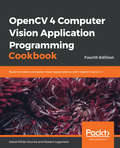- Table View
- List View
Open Space: The Global Effort for Open Access to Environmental Satellite Data (Information Policy)
by Mariel BorowitzAn examination of environmental satellite data sharing policies, offering a model of data-sharing policy development, case and practical recommendations for increasing global data sharing.Key to understanding and addressing climate change is continuous and precise monitoring of environmental conditions. Satellites play an important role in collecting climate data, offering comprehensive global coverage that can't be matched by in situ observation. And yet, as Mariel Borowitz shows in this book, much satellite data is not freely available but restricted; this remains true despite the data-sharing advocacy of international organizations and a global open data movement. Borowitz examines policies governing the sharing of environmental satellite data, offering a model of data-sharing policy development and applying it in case studies from the United States, Europe, and Japan—countries responsible for nearly half of the unclassified government Earth observation satellites. Borowitz develops a model that centers on the government agency as the primary actor while taking into account the roles of such outside actors as other government officials and non-governmental actors, as well as the economic, security, and normative attributes of the data itself. The case studies include the U.S. National Aeronautics and Space Administration (NASA) and the U.S. National Oceanographic and Atmospheric Association (NOAA), and the United States Geological Survey (USGS); the European Space Agency (ESA) and the European Organization for the Exploitation of Meteorological Satellites (EUMETSAT); and the Japanese Aerospace Exploration Agency (JAXA) and the Japanese Meteorological Agency (JMA). Finally, she considers the policy implications of her findings for the future and provides recommendations on how to increase global sharing of satellite data.
Open Standards and the Digital Age
by Andrew L. RussellHow did openness become a foundational value for the networks of the twenty-first century? Open Standards and the Digital Age answers this question through an interdisciplinary history of information networks that pays close attention to the politics of standardization. For much of the twentieth century, information networks such as the monopoly Bell System and the American military's Arpanet were closed systems subject to centralized control. In the 1970s and 1980s, however, engineers in the United States and Europe experimented with design strategies to create new digital networks. In the process, they embraced discourses of "openness" to describe their ideological commitments to entrepreneurship, technological innovation, and participatory democracy. The rhetoric of openness has flourished - for example, in movements for open government, open source software, and open access publishing - but such rhetoric also obscures the ways the Internet and other "open" systems still depend heavily on hierarchical forms of control.
Open Text Metastorm ProVision® 6.2 Strategy Implementation
by Bill AronsonThis is both a practical and theoretical guide detailing how to deploy a successful ProVision® strategy, using a number of real business cases along the way. Unlike other architecture books, the approach is holistic - it looks at the whole lifecycle of building a business case, through to using the product. It combines a detailed understanding of the ProVision® toolset with a practical grasp of the business issues that affect the implementation of a successful strategy.If you are a business architect or CIO in a large organization who wants to implement a successful strategy using Open Text ProVision®, then this book is for you. It will also be of interest if you are an enterprise designer or architect. It might be that you already have working knowledge of ProVision®, but do not yet have the skill to implement it in the right context; this book will help you get there.
Open World Learning: Research, Innovation and the Challenges of High-Quality Education (Routledge Research in Digital Education and Educational Technology)
by Regine Hampel Eileen Scanlon Bart Rienties Denise WhitelockThis book provides state-of-the-art contemporary research insights into key applications and processes in open world learning. Open world learning seeks to understand access to education, structures, and the presence of dialogue and support systems. It explores how the application of open world and educational technologies can be used to create opportunities for open and high-quality education. Presenting ground-breaking research from an award winning Leverhulme doctoral training programme, the book provides several integrated and cohesive perspectives of the affordances and limitations of open world learning. The chapters feature a wide range of open world learning topics, ranging from theoretical and methodological discussions to empirical demonstrations of how open world learning can be effectively implemented, evaluated, and used to inform theory and practice. The book brings together a range of innovative uses of technology and practice in open world learning from 387,134 learners and educators learning and working in 136 unique learning contexts across the globe and considers the enablers and disablers of openness in learning, ethical and privacy implications, and how open world learning can be used to foster inclusive approaches to learning across educational sectors, disciplines and countries. The book is unique in exploring the complex, contradictory and multi-disciplinary nature of open world learning at an international level and will be of great interest to academics, researchers, professionals, and policy makers in the field of education technology, e-learning and digital education.
Open and Big Data Management and Innovation
by Marijn Janssen Bram Klievink Matti Mäntymäki Jan Hidders Winfried Lamersdorf Bastiaan Van Loenen Anneke ZuiderwijkThis book constitutes the refereed conference proceedings of the 14th IFIP WG 6. 11 Conference on e-Business, e-Services and e-Society, I3E 2015, held in Delft, The Netherlands, in October 2015. The 40 revised full papers presented together with 1 keynote panel were carefully reviewed and selected from 65 submissions. They are organized in the following topical sections: adoption; big and open data; e-business, e-services,, and e-society; and witness workshop.
Open and Digital Ecosystems: Added Value Through Industry and Technology Convergence
by Daniel FasnachtDive into the fascinating world of digital disruption and discover the transformative power of open and digital ecosystems, which will constitute one-third of global trade by 2030. This book demonstrates how value creation occurs beyond organizational boundaries and places the consumer at the forefront. The convergence of industries and technologies drives the experience-oriented customer journey and accelerates digital transformation. Explore Artificial Intelligence, Augmented Reality, the Internet of Things, Blockchain, Cloud, and Quantum Computing as key building blocks for innovation. The golden triangle of digital ecosystems - commerce, social media, and finance – illustrates how companies like Alibaba, Tencent, NIO, Alphabet, Apple, Amazon, and Migros create unique customer experiences and integrate services with super-apps. Through in-depth analyses and practical case studies, you will learn how companies can thrive in this revolutionary model, achieving growth by sharing knowledge and resources, responding swiftly to market changes, and balancing the optimization of existing businesses with the exploration of new opportunities. Leadership in open and digital ecosystems demands a shift in mindset and the development of new dynamic capabilities. Emphasizing openness, agility, and ambidexterity as critical skills, this book is an indispensable guide for companies aiming to leverage open and digital ecosystems for sustainable growth and to build agile, resilient organizations. Gain a modern understanding of leadership and discover how it shapes the future of work in the era of digital ecosystems.
Open and Distance Education Theory Revisited: Implications for the Digital Era (SpringerBriefs in Education)
by Insung JungThis book explores foundational theories that have been applied in open and distance education (ODE) research and refined to reflect advances in research and practice. In addition, it develops new theories emerging from recent developments in ODE. The book provides a unique and up-to-date source of information for ODE scholars and graduate students, enabling them to make sense of essential theory, research and practice in their field, and to comprehend the gaps in, and need for further enquiry into, theoretical approaches in the digital era. It also offers theory-based advice and guidelines for practitioners, helping them make and justify decisions and actions concerning the development, implementation, research and evaluation of ODE.
Open and Distance Education in Australia, Europe and the Americas: National Perspectives in a Digital Age (SpringerBriefs in Education)
by Olaf Zawacki-Richter Adnan QayyumThis book is open access under a CC BY 4.0 license.This book describes the history, structure and institutions of open and distance education in six countries: Australia, Brazil, Canada, Germany, the UK and the US. It discusses how open and distance education is evolving in a digital age to reflect the needs and circumstances of national higher education systems in these countries, and explores the similarities and differences between the ways in which they are organized and structured. It is the first book to make such comparisons and draw conclusions about the nature of open and distance education in the context of various national higher education systems. In a digital era with growing use of online education as well as open and distance education, this book is particularly useful for policy-makers and senior administrators who want to learn about organizing and expanding open and distance education provision. It is also a valuable reference for researchers, academics and students interested in understanding the different approaches to open and distance education.
Open and Distance Learning: Case Studies from Education Industry and Commerce (Open And Distance Learning Ser.)
by Stephen BrownThis contributed volume reviews the lessons that may be learned from trying to integrate distance learning strategies with face-to-face teaching methods. It contains practical examples from education, commerce and industry.
Open and Flexible Learning in Vocational Education and Training (Open and Flexible Learning Series)
by Judith Calder Ann McCollumThis text reviews the strategies adopted in a range of behaviourist approaches to the setting and realization of standards - identifying the background from which they emerged and ways in which they might be further developed.
Open-Advice
by Lydia PintscherOpen Advice is a knowledge collection from a wide variety of Free Software projects. It answers the question what 42 prominent contributors would have liked to know when they started so you can get a head-start no matter how and where you contribute.
Open-Set Text Recognition: Concepts, Framework, and Algorithms (SpringerBriefs in Computer Science)
by Chang Liu Xu-Cheng Yin Chun YangIn real-world applications, new data, patterns, and categories that were not covered by the training data can frequently emerge, necessitating the capability to detect and adapt to novel characters incrementally. Researchers refer to these challenges as the Open-Set Text Recognition (OSTR) task, which has, in recent years, emerged as one of the prominent issues in the field of text recognition. This book begins by providing an introduction to the background of the OSTR task, covering essential aspects such as open-set identification and recognition, conventional OCR methods, and their applications. Subsequently, the concept and definition of the OSTR task are presented encompassing its objectives, use cases, performance metrics, datasets, and protocols. A general framework for OSTR is then detailed, composed of four key components: The Aligned Represented Space, the Label-to-Representation Mapping, the Sample-to-Representation Mapping, and the Open-set Predictor. In addition,possible implementations of each module within the framework are discussed. Following this, two specific open-set text recognition methods, OSOCR and OpenCCD, are introduced. The book concludes by delving into applications and future directions of Open-set text recognition tasks.This book presents a comprehensive overview of the open-set text recognition task, including concepts, framework, and algorithms. It is suitable for graduated students and young researchers who are majoring in pattern recognition and computer science, especially interdisciplinary research.
Open-Source ESBs in Action: Example Implementations in Mule and ServiceMix
by Jos Dirksen Tijs RademakersMost modern business systems include independent applications that exchange information with each other-a technique usually called enterprise integration. An architectural approach called the Enterprise Service Bus (ESB) offers developers a way to handle the messages between those independent applications without creating a lot of custom code. While commercial ESB solutions can be quite expensive to implement and maintain, a set of high-quality open source ESB tools offer the same functionality at a substantially lower cost.Open Source ESBs in Action shows you how to implement and use two open source ESB implementations: Mule and ServiceMix. The authors introduce you to these freely-available ESB tools and present practical examples of how to use them in real-world scenarios. You will learn how the various features of an ESB such as transformation, routing, security, connectivity and more can be implemented using Mule and ServiceMix. You will also learn how to solve common enterprise integration problems using a structured approach.Beyond simply learning how Mule and Service Mix work, you'll learn the core techniques of ESB implementation such as Process Choreography, or the implementation of complex business processes through an ESB, and Service Orchestration, or exposing a set of services as a single service. The book shows you the fundamentals of ESB-based event processing and Quality of Service concerns like security, reliable delivery, and transaction management.Working in integration projects is exciting, with new technologies and paradigms arriving every day. Open Source technologies like Mule and ServiceMix both offer lower-cost solutions and a higher degree of innovation than commercial ESB implementations. Open Source ESBs in Action will help you master ESB-driven integration techniques quickly and will provide you with knowledge you need to work effectively with Mule and ServiceMix. Purchase of the print book comes with an offer of a free PDF, ePub, and Kindle eBook from Manning. Also available is all code from the book.
Open-Source Security Operations Center (SOC): A Complete Guide to Establishing, Managing, and Maintaining a Modern SOC
by Alfred Basta Nadine Basta Waqar Anwar Mohammad Ilyas EssarA comprehensive and up-to-date exploration of implementing and managing a security operations center in an open-source environment In Open-Source Security Operations Center (SOC): A Complete Guide to Establishing, Managing, and Maintaining a Modern SOC, a team of veteran cybersecurity practitioners delivers a practical and hands-on discussion of how to set up and operate a security operations center (SOC) in a way that integrates and optimizes existing security procedures. You’ll explore how to implement and manage every relevant aspect of cybersecurity, from foundational infrastructure to consumer access points. In the book, the authors explain why industry standards have become necessary and how they have evolved – and will evolve – to support the growing cybersecurity demands in this space. Readers will also find: A modular design that facilitates use in a variety of classrooms and instructional settingsDetailed discussions of SOC tools used for threat prevention and detection, including vulnerability assessment, behavioral monitoring, and asset discoveryHands-on exercises, case studies, and end-of-chapter questions to enable learning and retention Perfect for cybersecurity practitioners and software engineers working in the industry, Open-Source Security Operations Center (SOC) will also prove invaluable to managers, executives, and directors who seek a better technical understanding of how to secure their networks and products.
Open: How Compaq Ended IBM's PC Domination and Helped Invent Modern Computing
by Rod CanionThe story of Compaq is well-known: Three ex-Texas Instruments managers founded Compaq with modest venture funding. Just four years later, Compaq was on the Fortune 500 list, and, two years after that, they had exceeded $1 billion in annual revenue. No company had ever achieved these milestones so rapidly. But few know the story behind the story. In 1982, when Compaq was founded, there was no software standardization, so every brand of personal computer required its own unique application software. Just eight years later, compatibility with the open PC standard had become ubiquitous, and it has continued to be for over two decades. This didn't happen by accident. Cofounder and then CEO Rod Canion and his team made a series of risky and daring decisions—often facing criticism and incredulity—that allowed the open PC standard marketplace to thrive and the incredible benefits of open computing to be realized. A never-before-published insider account of Compaq's extraordinary strategies and decisions, Open provides valuable lessons in leadership in times of crisis, management decision-making under the pressure of extraordinary growth, and the power of a unique, pervasive culture. Open tells the incredible story of Compaq's meteoric rise from humble beginnings to become the PC industry leader in just over a decade. Along the way, Compaq helped change the face of computing while establishing the foundation for today's world of tablets and smart phones.
OpenAM
by Indira ThangasamyThis book is a step-by-step tutorial stuffed with practical, real-world examples. It is designed in such a way that if you are already familiar with OpenAM, you can easily skip to a later chapter without missing a beat. You should be able to quickly grasp the basic elements of OpenAM before moving on to the more advanced features and functionality. If you are a security architect or a solution developer responsible for the design and development of web-based enterprise applications that need to provide authentication, authorization, and audit facilities along with SSO capabilities, then this book is for you. You do not require any prior knowledge of OpenAM to read this book. Familiarity with Java will be helpful, but is not essential.
OpenCL Parallel Programming Development Cookbook
by Raymond TayOpenCL Parallel Programming Development Cookbook will provide a set of advanced recipes that can be utilized to optimize existing code. This book is therefore ideal for experienced developers with a working knowledge of C/C++ and OpenCL.This book is intended for software developers who have often wondered what to do with that newly bought CPU or GPU they bought other than using it for playing computer games; this book is also for developers who have a working knowledge of C/C++ and who want to learn how to write parallel programs in OpenCL so that life isn't too boring.
OpenCL Programming by Example
by Koushik Bhattacharyya Ravishekhar BangerThis book follows an example-driven, simplified, and practical approach to using OpenCL for general purpose GPU programming.If you are a beginner in parallel programming and would like to quickly accelerate your algorithms using OpenCL, this book is perfect for you! You will find the diverse topics and case studies in this book interesting and informative. You will only require a good knowledge of C programming for this book, and an understanding of parallel implementations will be useful, but not necessary.
OpenCL in Action: How to accelerate graphics and computations
by Matthew ScarpinoSummaryOpenCL in Action is a thorough, hands-on presentation of OpenCL, with an eye toward showing developers how to build high-performance applications of their own. It begins by presenting the core concepts behind OpenCL, including vector computing, parallel programming, and multi-threaded operations, and then guides you step-by-step from simple data structures to complex functions.About the TechnologyWhatever system you have, it probably has more raw processing power than you're using. OpenCL is a high-performance programming language that maximizes computational power by executing on CPUs, graphics processors, and other number-crunching devices. It's perfect for speed-sensitive tasks like vector computing, matrix operations, and graphics acceleration.About this BookOpenCL in Action blends the theory of parallel computing with the practical reality of building high-performance applications using OpenCL. It first guides you through the fundamental data structures in an intuitive manner. Then, it explains techniques for high-speed sorting, image processing, matrix operations, and fast Fourier transform. The book concludes with a deep look at the all-important subject of graphics acceleration. Numerous challenging examples give you different ways to experiment with working code.A background in C or C++ is helpful, but no prior exposure to OpenCL is needed. Purchase of the print book comes with an offer of a free PDF, ePub, and Kindle eBook from Manning. Also available is all code from the book. What's InsideLearn OpenCL step by stepTons of annotated codeTested algorithms for maximum performance***********Table of ContentsPART 1 FOUNDATIONS OF OPENCL PROGRAMMINGIntroducing OpenCLHost programming: fundamental data structuresHost programming: data transfer and partitioningKernel programming: data types and device memoryKernel programming: operators and functionsImage processingEvents, profiling, and synchronizationDevelopment with C++ Development with Java and PythonGeneral coding principlesPART 2 CODING PRACTICAL ALGORITHMS IN OPENCLReduction and sortingMatrices and QR decompositionSparse matricesSignal processing and the fast Fourier transformPART 3 ACCELERATING OPENGL WITH OPENCLCombining OpenCL and OpenGLTextures and renderbuffers
OpenCV 2 Computer Vision Application Programming Cookbook
by Robert LaganiereThis is a cookbook that shows results obtained on real images with detailed explanations and the relevant screenshots. The recipes contain code accompanied with suitable explanations that will facilitate your learning. If you are a novice C++ programmer who wants to learn how to use the OpenCV library to build computer vision applications, then this cookbook is appropriate for you. It is also suitable for professional software developers wishing to be introduced to the concepts of computer vision programming. It can be used as a companion book in university-level computer vision courses. It constitutes an excellent reference for graduate students and researchers in image processing and computer vision. The book provides a good combination of basic to advanced recipes. Basic knowledge of C++ is required.
OpenCV 3 Blueprints
by Joseph Howse Steven Puttemans Quan Hua Utkarsh SinhaExpand your knowledge of computer vision by building amazing projects with OpenCV 3About This BookBuild computer vision projects to capture high-quality image data, detect and track objects, process the actions of humans or animals, and much moreDiscover practical and interesting innovations in computer vision while building atop a mature open-source library, OpenCV 3Familiarize yourself with multiple approaches and theories wherever critical decisions need to be madeWho This Book Is ForThis book is ideal for you if you aspire to build computer vision systems that are smarter, faster, more complex, and more practical than the competition. This is an advanced book intended for those who already have some experience in setting up an OpenCV development environment and building applications with OpenCV. You should be comfortable with computer vision concepts, object-oriented programming, graphics programming, IDEs, and the command line.What You Will LearnSelect and configure camera systems to see invisible light, fast motion, and distant objectsBuild a "camera trap", as used by nature photographers, and process photos to create beautiful effectsDevelop a facial expression recognition system with various feature extraction techniques and machine learning methodsBuild a panorama Android application using the OpenCV stitching module in C++ with NDK supportOptimize your object detection model, make it rotation invariant, and apply scene-specific constraints to make it faster and more robustCreate a person identification and registration system based on biometric properties of that person, such as their fingerprint, iris, and faceFuse data from videos and gyroscopes to stabilize videos shot from your mobile phone and create hyperlapse style videosIn DetailComputer vision is becoming accessible to a large audience of software developers who can leverage mature libraries such as OpenCV. However, as they move beyond their first experiments in computer vision, developers may struggle to ensure that their solutions are sufficiently well optimized, well trained, robust, and adaptive in real-world conditions. With sufficient knowledge of OpenCV, these developers will have enough confidence to go about creating projects in the field of computer vision.This book will help you tackle increasingly challenging computer vision problems that you may face in your careers. It makes use of OpenCV 3 to work around some interesting projects. Inside these pages, you will find practical and innovative approaches that are battle-tested in the authors' industry experience and research. Each chapter covers the theory and practice of multiple complementary approaches so that you will be able to choose wisely in your future projects. You will also gain insights into the architecture and algorithms that underpin OpenCV's functionality.We begin by taking a critical look at inputs in order to decide which kinds of light, cameras, lenses, and image formats are best suited to a given purpose. We proceed to consider the finer aspects of computational photography as we build an automated camera to assist nature photographers. You will gain a deep understanding of some of the most widely applicable and reliable techniques in object detection, feature selection, tracking, and even biometric recognition. We will also build Android projects in which we explore the complexities of camera motion: first in panoramic image stitching and then in video stabilization.By the end of the book, you will have a much richer understanding of imaging, motion, machine learning, and the architecture of computer vision libraries and applications!Style and approachThis book covers a combination of theory and practice. We examine blueprints for specific projects and discuss the principles behind these blueprints, in detail.
OpenCV 3 Computer Vision Application Programming Cookbook - Third Edition
by Robert LaganiereRecipes to help you build computer vision applications that make the most of the popular C++ library OpenCV 3 About This Book • Written to the latest, gold-standard specification of OpenCV 3 • Master OpenCV, the open source library of the computer vision community • Master fundamental concepts in computer vision and image processing • Learn about the important classes and functions of OpenCV with complete working examples applied to real images Who This Book Is For OpenCV 3 Computer Vision Application Programming Cookbook Third Edition is appropriate for novice C++ programmers who want to learn how to use the OpenCV library to build computer vision applications. It is also suitable for professional software developers who wish to be introduced to the concepts of computer vision programming. It can also be used as a companion book for university-level computer vision courses. It constitutes an excellent reference for graduate students and researchers in image processing and computer vision. What You Will Learn • Install and create a program using the OpenCV library • Process an image by manipulating its pixels • Analyze an image using histograms • Segment images into homogenous regions and extract meaningful objects • Apply image filters to enhance image content • Exploit the image geometry in order to relay different views of a pictured scene • Calibrate the camera from different image observations • Detect people and objects in images using machine learning techniques • Reconstruct a 3D scene from images In Detail Making your applications see has never been easier with OpenCV. With it, you can teach your robot how to follow your cat, write a program to correctly identify the members of One Direction, or even help you find the right colors for your redecoration. OpenCV 3 Computer Vision Application Programming Cookbook Third Edition provides a complete introduction to the OpenCV library and explains how to build your first computer vision program. You will be presented with a variety of computer vision algorithms and exposed to important concepts in image and video analysis that will enable you to build your own computer vision applications. This book helps you to get started with the library, and shows you how to install and deploy the OpenCV library to write effective computer vision applications following good programming practices. You will learn how to read and write images and manipulate their pixels. Different techniques for image enhancement and shape analysis will be presented. You will learn how to detect specific image features such as lines, circles or corners. You will be introduced to the concepts of mathematical morphology and image filtering. The most recent methods for image matching and object recognition are described, and you'll discover how to process video from files or cameras, as well as how to detect and track moving objects. Techniques to achieve camera calibration and perform multiple-view analysis will also be explained. Finally, you'll also get acquainted with recent approaches in machine learning and object classification. Style and approach This book will arm you with the basics you need to start writing world-aware applications right from a pixel level all the way through to processing video sequences.
OpenCV 3 Computer Vision with Python Cookbook: Leverage the power of OpenCV 3 and Python to build computer vision applications
by Aleksei Spizhevoi Aleksandr RybnikovRecipe-based approach to tackle the most common problems in Computer Vision by leveraging the functionality of OpenCV using Python APIsKey Features●Build computer vision applications with OpenCV functionality via Python API●Get to grips with image processing, multiple view geometry, and machine learning●Learn to use deep learning models for image classification, object detection, and face recognitionBook DescriptionOpenCV 3 is a native cross-platform library for computer vision, machine learning, and image processing. OpenCV's convenient high-level APIs hide very powerful internals designed for computational efficiency that can take advantage of multicore and GPU processing. This book will help you tackle increasingly challenging computer vision problems by providing a number of recipes that you can use to improve your applications.In this book, you will learn how to process an image by manipulating pixels and analyze an image using histograms. Then, we'll show you how to apply image filters to enhance image content and exploit the image geometry in order to relay different views of a pictured scene. We’ll explore techniques to achieve camera calibration and perform a multiple-view analysis.Later, you’ll work on reconstructing a 3D scene from images, converting low-level pixel information to high-level concepts for applications such as object detection and recognition. You’ll also discover how to process video from files or cameras and how to detect and track moving objects. Finally, you'll get acquainted with recent approaches in deep learning and neural networks.By the end of the book, you’ll be able to apply your skills in OpenCV to create computer vision applications in various domains.What you will learn●Get familiar with low-level image processing methods●See the common linear algebra tools needed in computer vision●Work with different camera models and epipolar geometry●Find out how to detect interesting points in images and compare them●Binarize images and mask out regions of interest●Detect objects and track them in videosWho this book is forThis book is for developers who have a basic knowledge of Python. If you are aware of the basics of OpenCV and are ready to build computer vision systems that are smarter, faster, more complex, and more practical than the competition, then this book is for you.
OpenCV 3.x with Python By Example: Make the most of OpenCV and Python to build applications for object recognition and augmented reality
by Prateek Joshi Naren Yellavula Gabriel Garrido CalvoLearn the techniques for object recognition, 3D reconstruction, stereo imaging, and other computer vision applications using examples on different functions of OpenCV. Key Features Learn how to apply complex visual effects to images with OpenCV 3.x and Python Extract features from an image and use them to develop advanced applications Build algorithms to help you understand image content and perform visual searches Get to grips with advanced techniques in OpenCV such as machine learning, artificial neural network, 3D reconstruction, and augmented reality Book Description Computer vision is found everywhere in modern technology. OpenCV for Python enables us to run computer vision algorithms in real time. With the advent of powerful machines, we have more processing power to work with. Using this technology, we can seamlessly integrate our computer vision applications into the cloud. Focusing on OpenCV 3.x and Python 3.6, this book will walk you through all the building blocks needed to build amazing computer vision applications with ease. We start off by manipulating images using simple filtering and geometric transformations. We then discuss affine and projective transformations and see how we can use them to apply cool advanced manipulations to your photos like resizing them while keeping the content intact or smoothly removing undesired elements. We will then cover techniques of object tracking, body part recognition, and object recognition using advanced techniques of machine learning such as artificial neural network. 3D reconstruction and augmented reality techniques are also included. The book covers popular OpenCV libraries with the help of examples. This book is a practical tutorial that covers various examples at different levels, teaching you about the different functions of OpenCV and their actual implementation. By the end of this book, you will have acquired the skills to use OpenCV and Python to develop real-world computer vision applications. What you will learn Detect shapes and edges from images and videos How to apply filters on images and videos Use different techniques to manipulate and improve images Extract and manipulate particular parts of images and videos Track objects or colors from videos Recognize specific object or faces from images and videos How to create Augmented Reality applications Apply artificial neural networks and machine learning to improve object recognitionWho this book is for This book is intended for Python developers who are new to OpenCV and want to develop computer vision applications with OpenCV and Python. This book is also useful for generic software developers who want to deploy computer vision applications on the cloud. It would be helpful to have some familiarity with basic mathematical concepts such as vectors, matrices, and so on.
OpenCV 4 Computer Vision Application Programming Cookbook: Build complex computer vision applications with OpenCV and C++, 4th Edition
by Robert Laganiere David Millán EscriváDiscover interesting recipes to help you understand the concepts of object detection, image processing, and facial detectionKey FeaturesExplore the latest features and APIs in OpenCV 4 and build computer vision algorithmsDevelop effective, robust, and fail-safe vision for your applicationsBuild computer vision algorithms with machine learning capabilitiesBook DescriptionOpenCV is an image and video processing library used for all types of image and video analysis. Throughout the book, you'll work through recipes that implement a variety of tasks, such as facial recognition and detection. With 70 self-contained tutorials, this book examines common pain points and best practices for computer vision (CV) developers. Each recipe addresses a specific problem and offers a proven, best-practice solution with insights into how it works, so that you can copy the code and configuration files and modify them to suit your needs.This book begins by setting up OpenCV, and explains how to manipulate pixels. You'll understand how you can process images with classes and count pixels with histograms. You'll also learn detecting, describing, and matching interest points. As you advance through the chapters, you'll get to grips with estimating projective relations in images, reconstructing 3D scenes, processing video sequences, and tracking visual motion. In the final chapters, you'll cover deep learning concepts such as face and object detection.By the end of the book, you'll be able to confidently implement a range to computer vision algorithms to meet the technical requirements of your complex CV projectsWhat you will learnInstall and create a program using the OpenCV librarySegment images into homogenous regions and extract meaningful objectsApply image filters to enhance image contentExploit image geometry to relay different views of a pictured sceneCalibrate the camera from different image observationsDetect people and objects in images using machine learning techniquesReconstruct a 3D scene from imagesExplore face detection using deep learningWho this book is forIf you’re a CV developer or professional who already uses or would like to use OpenCV for building computer vision software, this book is for you. You’ll also find this book useful if you’re a C++ programmer looking to extend your computer vision skillset by learning OpenCV.
